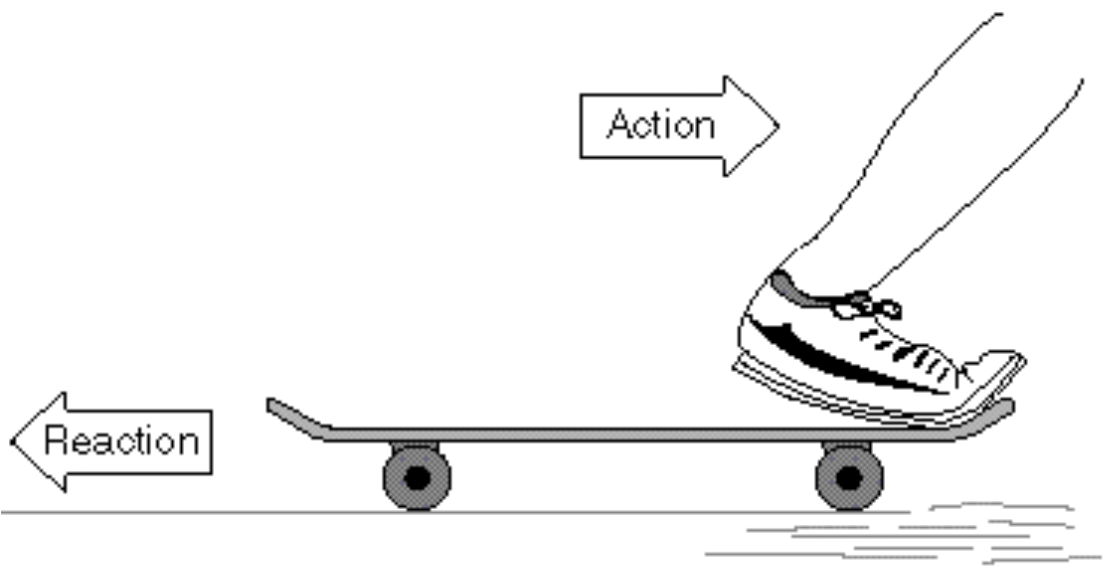
Therefore we do not add vectors of the forces of action and reaction.Ĥ1 With the exception of inertia forces in mechanics. Whenever one body exerts a force on a second body, the second body exerts an oppositely directed force of equal magnitude on the first body. It only states that forces arise in pairs and that each of them act on a different body. Newton’s 3rd Law: If an object A exerts a force on object B, then object B must exert a force of equal magnitude and opposite direction back on object A. But it does not directly state what motions of bodies forces cause. Newton's Third Law helps us to explain how forces act and what they act on. The bigger the mass of a player, the less kinetic effect (acceleration) we can see after a collision with a player of lesser mass. In such a collision we can see that ramming into an opponent with less mass has more kinetic effect. Because the smaller forward has less mass, after the collision he will accelerate in the direction of the force exerted by the defenseman (assuming their foothold is the same). Which of them exerts a greater force? They both exert forces of the same magnitude but opposite direction (Newton's Third Law)! What, however, is the effect of these forces? From Newton's Second Law we know that acceleration of a body depends not only on force but also on mass.

Let us have a look at a situation when a big ice hockey defenseman rams into a smaller forward who is moving with the same velocity but in the opposite direction. However, Jaromír Jágr smartly replied: „but being big also means that I have to cope with greater weight when I am boarded“.

When a journalist interviewed the hockey player Jaromír Jágr, he paid him a compliment: „being so big gives you an advantage when somebody tries to board you“. Think of a few everyday examples: When you jump, a force is being exerted on your body, which makes you go UP. In other words, when a force is exerted in one direction, the same force is exerted in the opposite direction. When one body exerts a force on another body, the second body exerts a force on the first body that is equal in magnitude but opposite in direction. Newton’s third law of motion states: For every action, there is an equal and opposite reaction. We know that forces arise in interactions of two bodies 41. Learn about Newtons third law of motion, which states that for every action there is an equal and opposite reaction. This law lies behind the design of rocket propulsion, in which matter forced out of a burner at high speeds creates an equal force driving the rocket forward.For every action, there is an equal and opposite reaction.īy action and reaction it is meant action and reaction forces.

Thus, if one body exerts a force F on a second body, the first body also undergoes a force of the same strength but in the opposite direction. ♦ Newton's third law states that for every action there is an equal and opposite reaction. Expressed mathematically, F = ma, where F is the force in Newtons, m is the mass of the body in kilograms, and a is the acceleration in meters per second per second. According to Newtons third law of motion, when one object exerts a force on a second object, the second object exerts a force on the first object of equal.

♦ Newton's second law states that a force acting on a body is equal to the acceleration of that body times its mass. This law is also called the law of inertia. ♦ Newton's first law states that a body at rest will remain at rest, and a body in motion will remain in motion with a constant velocity, unless acted upon by a force. These laws form the basis of classical mechanics and were elemental in solidifying the concepts of force, mass, and inertia. The three laws proposed by Sir Isaac Newton concerning relations between force, motion, acceleration, mass, and inertia.


 0 kommentar(er)
0 kommentar(er)
